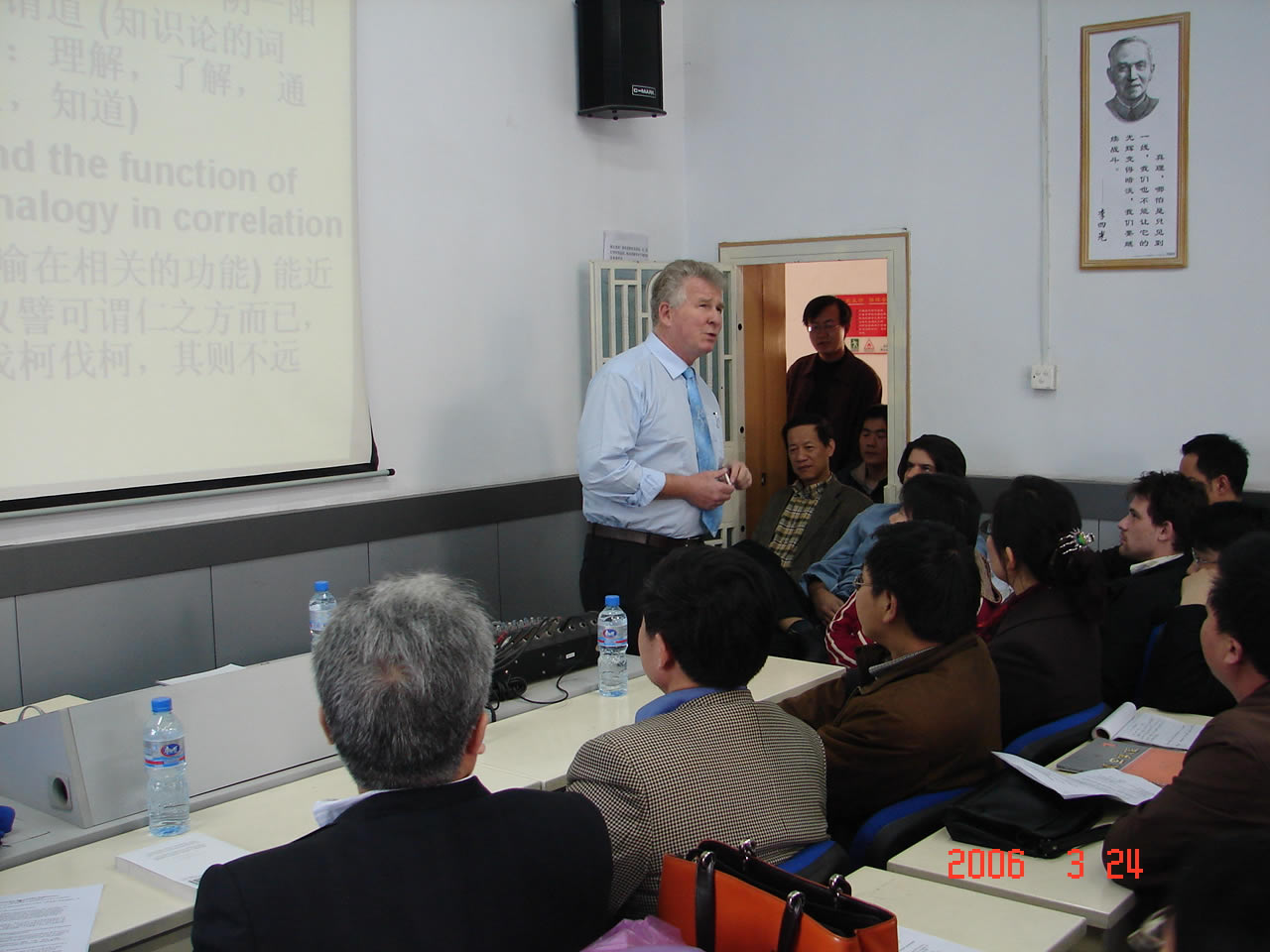
应山东大学易学与中国古代哲学研究中心的邀请,美国夏威夷大学哲学系教授安乐哲(Roger T. Ames)先生于2006年3月24日来山东大学讲学。
安乐哲先生是美国夏威夷大学哲学系教授,美国东西文化交流中心亚洲发展项目负责人,北大、香港中大、台湾大学客座教授,国际《东西方哲学》杂志主编,国际知名比较哲学家,对东西方哲学尤其是实用主义哲学与儒家哲学的会通有比较深入的研究,为推动中西文化交流、尤其是中西哲学思想的对话做出了卓越的贡献。
安乐哲教授关于中西比较哲学的系列著作主要有:
《通过孔子而思》(Thinking through Confucius)
《汉哲学思维的文化探源》(Thinking from the Han: Self, Truth,and Transcendence in Chinese and Western Culture)
《期待中国:探求中国和西方的文化叙述》(Anticipating China:Thinking through the Narratives of Chinese and Western Culture)
《主术:中国古代政治思想研究》(The Art of Rulership: A Studyin Ancient Chinese Political Thought)
《先哲的民主:杜威、孔子和中国民主之希望》(The Democracy of the Dead:Dewey, Confucius, and the Hope for Democracy in China)
《中国哲学问题》等。
安乐哲先生演讲提纲:
1. “Chinese wisdom has no need for the idea of God” 中国智慧不依靠超越性上帝的观念 (M. Granet)
2. Dewey 杜威on Darwin: 两个不同常识的可能性
There are, indeed, but two alternative courses. We must either find the appropriate objects and organs of knowledge in the mutual interactions of changing things; or else, to escape the infection of change, we must seek them in some transcendent and supernal region. The human mind, deliberately as it were, exhausted the logic of the changeless, the final and the transcendent, before it essayed adventure on the pathless wastes of generation and transformation.
我们只有两个不同的路向能走。我们必得在一直改变事物的相互关系找到知识合适的对象与构成器官,或者为了逃掉变化的污染影响,我们必须在一些超自然的、超越性的场域找到这杨东西。我们人类心灵很,复杂如此,探索无变对象的逻辑,才开始踏入到生生不息变化的无路野泽之中。
3. Two kinds of commonsense: Metaphysical realism and Confucian pragmatism
常识的两种:形而生学性的实在主义与儒学实用主义
a) Pythagoras: mathematics as the model for apodictic knowledge 数学为决定无条件性知识的模型 1 + 1 = 2 (知识论的词汇:”to comprehend, to get, to grasp, to understand”) and the function of reason in analysis (理性在分析方法的功能)
b). Yijing 易经: 一阴一阳之谓道 (知识论的词汇:理解,了解, 通达,知道)
and the function of analogy in correlation (比喻在相关的功能) 能近取譬可谓仁之方而已,伐柯伐柯,其则不远
4. Substance ontology 本质性的本体论 Process cosmology 过程性的自然宇宙论
a) universals and particulars 共相与殊相 a) focus- field 点域论:万物皆备于我矣
Being behind beings Continuity of one and many
表象后的实在 一多不分观 (万物与我为一)
One behind the many Ontological parity among things
多种事物后的唯一实在 齐物论
Supernatural God and natural world Correlative cosmology
超越性上帝与自然世界 关联宇宙论
b) priority of form and stasis b) priority of transformation
形式与静止的优先 动力性的体用, 变通,德道的优先
c) essential “things” 本质性的事物 c) related “events” 关系性的现象
external relations internal constitutive relations
外在地关联着的 内在构成性地关联着的
only Being is 只有”在”存在 only becomings are 只有生成存在
integrity 终结 integrity (integration) 生成为一
atomistic individual原子性个别人物 organic, relations有机性,大家,礼
d) creatio ex nihilo 世界产生于虚无 d) creatio in situ 情境性的创造
discrete agency: creator or creature situated agency: co-creativity
retrospective origins prospective significance, original, heroic genius, novelty collaborative, virtuosic sage 圣人
power and dependence interdependence, mutuality
non-empirical, timeless source historical, empirical source
antecedents, precedents consequences, possibilities
void (nihil) outside of experience 无 as in 道冲 (盅)
5. First test case 第一试验案件: “Creativity” in the Zhongyong 中庸的创造观
a) 天命之谓性,率性之谓道,修道之谓教
b) James Legge’s indictment: celebration of human creativity 人配天,天人合一, 至圣,至诚
c) ZY20: 诚者天之道也,诚之者人之道也
d) ZY25: 诚as “sincerity, integrity, co-creativity, creativity”
e) the gerundive dao 动名词性的道: way-making (not the Way)
f) the problem with the English word “creativity”
6. Second text case 第二试验案件: “Human nature” in Xingzimingchu and Wuxingpian 性自命出与五行篇的人性观